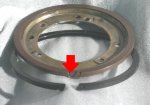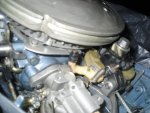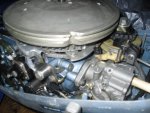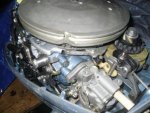Re: 1975 evinrude 9.9 fuel pump prob?
I second that. Once you get it going, put it in gear to allow you to go past the neutral stop if you need to. Obviously don't over rev it, but see if you can keep it going with more gas.
When looking at the last couple of videos, it seems to me that both cylinders start slowing down and then one fails and then the other. Now, if it was the pump or carburetor, I would think that both cylinders would fail at the same time.
So that leaves me thinking spark and/or spark timing. I think we can rule out condensers and probably points. Perhaps your main driver coil is failing after it heats up. Also, on Leeroy's site he talks about a loose timing plate:
------------
Timing Plate loose: This can be an item that may be overlooked, but it can be critical. Under the flywheel is what I call the timing plate assembly, this is essentially the whole charge coil/ignition module under the flywheel. It rotates when you twist the throttle twist grip. If the "Ignition plate to support bearing" (#47 ) or part #322435, becomes worn or warped, it will then be loose, this will allow the whole timing plate to rotate under the flywheel by the force of the flywheel magnets rotating around the coils mounted on the plate. This will cause the throttle timing to possibly change enough to create a non-starting motor. This support bearing puts tension on the inside of the timing plate dia. What usually happens is that someone oils everything up & this being one that gets a shot. It needs FRICTION not lubrication. You may be able to clean it up, then warm it in a micro wave & expand the ends to make it a larger dia.
This "bearing" is a fiber ring 5" in diameter, 3/16" thick & 1/4" wide. It is has a groove around in the inside to fit over the plate, & split in the middle like a set of piston ring to allow installation. If it is collapsed, meaning it has both ends almost together, it will not be able to put enough pressure on the timing plate. You may be able to put it in a micro-wave for a few seconds to soften it up, allowing you to spread it back out & be reusable. When installed it acts as a bushing excreting circular friction between upper plate & the block. The thickness up & down is not where the tension is put between the two but the outer circumference pressure.
There are 4 parts that constitute that this timing plate/stator assembly. First there is reference #41 or "timing plate retainer & link", next #46 is the "support plate" onto which is attached #47 bearing, ignition plate support" which is a plastic type large ring with a groove in the center. The outer edges of this plate #46 accepts #47 bearing. This bearing is made larger in diameter & has angled ends to be compressed & ride inside the #39 "timing plate & sleeve" unit that the stator is attached to. However it will not just slide on.
You will have to make a simple small wire staple that will hold the 2 ends in place while you slide #39 down over this #47 bearing. The best I have found is to place the bearing so the joint is pointing straight to the rear. Slide the timing plate assembly down & usually the staple will fall out, if not you can reach in with an ice pick & dislodge it from the bearing. Now it will fall on top of the block, so you can retrieve it with a small magnet. The red arrow in the photo below is pointing to the staple. The other bearing shown below is the position the normal bearing is extended. One is brown while the other is black, no difference, just possibly a different year."
http://www.sschapterpsa.com/ramblings/Johnson_9.9_troubleshooting.htm
--------------
I think I remember BK asking about a loose mag plate and perhaps you have checked this. Those are my thoughts. A last thought might be a partially sheered flywheel key if it hasn't been addressed yet.























